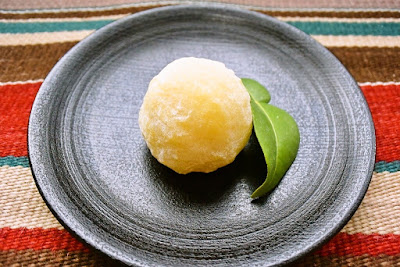Yuzu daifuku / soft rice cake with sweetened bean paste and candied yuzu citrus peel
This sweet rice cake will send your senses into overdrive as you bite into the soft rice cake envelope that surrounds silky sweet bean paste and candied yuzu peel. The shiroan below straightforwardly delivers invigorating yuzu aroma. If you prefer a deeper taste, try pairing yuzu peel with azuki koshian, or strained tsubuan for a slightly more complex taste. All taste a bit different but are equally good. Great with unsweetened Japanese or Chinese tea.One daifuku cake (1/4 of recipe; figures for granulated sugar for yuzu peel excluded):
87 calories; 2.4 g protein; 0.3 g fat; 18.5 g carbohydrate; 18.6 g net carbs; 5 mg sodium; 0 mg cholesterol; 2.0 g fiber
<Ingredients>
(Makes 4 daifuku cakes)
For gyuhi mochi
35 g shiratamako sweet rice powder
20 g sugar
5 g mizuame starch syrup
70 cc water
1 small orange beet (only 2 cm or so required)
For yuzuan citrus sweet bean paste
80 g shiroan lima bean paste
5-6 g candied yuzu peel
3-4 tbsp katakuriko potato starch (to prevent gyuhi mochi from sticking to tray and hands; not in photo)
<Directions>
1.
Make yuzuan.
Chop yuzu peel into 3-4 mm squares.
Mix with shiroan bean paste, and let sit for a few hours to overnight (if you can't wait, as long as possible; even 30 minutes make a difference).
2.
Divide yuzuan into four, and make round balls.
Sift katakuriko potato starch onto tray, covering a relatively large area (potato starch prevents gyuhi from sticking to tray surface).
3.
Make gyuhi soft mochi rice cake.
Skin and grate orange beet into a separate small container, and pour some water from the 70cc of water.
Strain beet colored water into shiratamako in a microwaveable bowl, and mix well.
Grate more beet, and repeat until achieving desired color.
Make sure all shiratamako lumps are gone while blending with water.
Add sugar, mizuame and remaining water, and mix well.
4.
Loosely cover bowl, and microwave for 30-40 seconds.
Remove, and mix well with moistened spatula.
Cover and microwave again for 30 seconds. Remove, and mix well with moistened spatula.
Repeat one more time, microwaving for a shorter time (20-30 seconds).
Gyuhi is ready when somewhat translucent and supple.
Empty gyuhi on tray covered with potato starch.
If gyuhi is in the shape of an oblong blob, put potato starch on long sides, and flip over (fold in half) with fingers, and make a log form.
5.
Squeeze or pinch between fingers to divide gyuhi in half, then divide each half into two to get a total of four mochi pieces.
Flatten a gyuhi mochi piece, aiming to make the center thinner and outside fatter.
Place yuzuan, and wrap.
Gyuhi is very sticky if not covered with potato starch. Put more potato starch on outer surface of gyuhi as you stretch it to wrap yuzuan.
When finished wrapping, place daifuku on your palm with closed side at bottom, and roll with fingers of your other hand to shape it into a globe (or gently press with your other palm to form round cushion shape).
Ready to serve.
<Notes>
- No yuzu peel? Try orange peel. It is also very tasty. Photo at right is orange peel daifuku where gyuhi is colored with grated carrot.
- Coloring gyuhi with beet or carrot does not affect the taste to any noticeable degree.
- To make candied yuzu peel, the process is basically the same as orange peel. With yuzu, the white part of rind is quite bitter. After peeling off rind, soak in water for several hours to overnight, while changing water several times (this softens white part while reducing its bitterness), and remove white part as much as possible or as desired. Check weight of yuzu peel at this point; sugar amount should be 40-70% of yuzu peel weight. Place yuzu peel in pot with water, boil and simmer, drain, and repeat one or two times. In a clean pot, place sugar and some water (1-2 cm height; add yuzu juice if desired), heat to melt sugar, place yuzu peel (and yuzu seeds if desired; this makes a jelly-like syrup), and simmer for 20 minutes or so until somewhat translucent. Remove from syrup, dry on a tray for 1-2 days, and sprinkle granulated sugar to coat surface.


Congratulations! Just now you have made Yuzu daifuku / soft rice cake with sweetened bean paste and candied yuzu citrus peel with your own effort. I am happy, hopefully with this recipe article can make your life becomes happier. Find other recipes that are worth it for you to try at home only at Food Recipe
Thank you for reading Yuzu daifuku / soft rice cake with sweetened bean paste and candied yuzu citrus peel And this post url permalink is https://chinesefoodsrecipe.blogspot.com/2017/02/yuzu-daifuku-soft-rice-cake-with.html Hopefully This can be useful. Do not forget to share this paper until it can be useful for your friends




















0 Response to "Yuzu daifuku / soft rice cake with sweetened bean paste and candied yuzu citrus peel"
Post a Comment